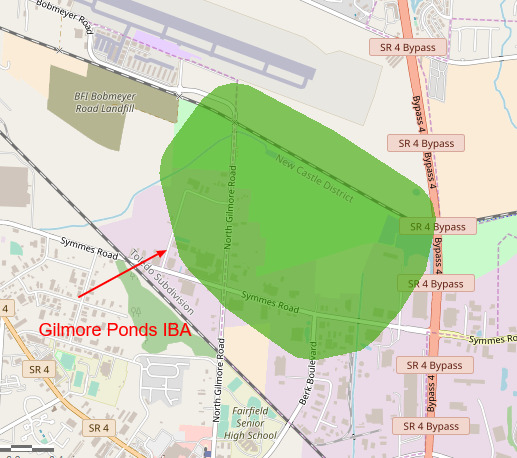Gilmore Ponds Important Bird Area
Gilmore Ponds
Important Bird Area
Explore in eBird
Entire Year – Spring – Summer – Fall – Winter
Locations

About Gilmore Ponds Important Bird Area
This IBA is primarily 200 acres of wetlands with associated former agricultural and disturbed field areas. It lies within the urban boundaries of the City of Hamilton, in the midst of an industrial park. On Ohio’s “Watchable Wildlife” list, Gilmore Ponds is bordered by two tributaries, Walker’s Run to the east, and the historic Miami-Erie Canal to the north. There is one permanent body of water, Old Ice Pond, which is just that–an old ice pond used in the late 19th and early 20th centuries to provide ice for use in Cincinnati-area breweries–and three larger ponds that flood seasonally and provide the best habitat for breeding and migrating waterfowl, shorebirds and long-legged waders such as Great Egrets, Black-crowned Night-Herons, Green Herons and Great Blue Herons. It is a rare area for wetland breeding species in southwestern Ohio, along with Miami Whitewater and Spring Valley.
The former Gilmore Ponds Conservancy created an annotated list of every bird species recorded at Gilmore Ponds since 1900. The list was created from four sources: Frank Renfrow’s 1983 report, ‘The Birds of Gilmore Ponds’; all the records pertaining to Gilmore Ponds from the database of the Cincinnati Bird Club, maintained by Ned Keller and David Styer; Tim Tolford’s banding records for 1998 and 1999; and the Gilmore Ponds breeding bird survey results from 1999 and 2000.
In wet years Gilmore Ponds offer migratory stop-over habitat and breeding habitat for a number of species of birds, including species of high conservation priority: Pied-billed Grebe, Least Bittern, Little Blue Heron, Cattle Egret, Black-crowned Night-Heron, American Black Duck, Northern Pintail, Peregrine Falcon, King Rail, Virginia Rail, Common Moorhen, American Coot, Purple Martin, Winter Wren, Hermit Thrush, Blue-winged Warbler, Magnolia Warbler, Prothonotary Warbler, and Northern Waterthrush. At such times its also furnishes habitat for breeding and migrating waterfowl, shorebirds, and long-legged waders such as Great Egrets, Black-crowned Night-Herons, Green Herons and Great Blue Herons. Numbers are greatest in the spring and fall during migration, but if the spring is wet enough Gilmore Ponds is sure to be host to a number of wetland birds, some of which even breed there from time to time. Among the usual visitors and sometime-breeders are Pied-billed Grebe, Common Moorhen, American Coot, Green Heron, Black-crowned Night-Heron, Least Bittern, Prothonotary Warbler, and Willow Flycatcher. Rusty Blackbirds are often seen in season and American Woodcocks display.